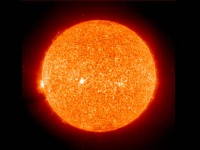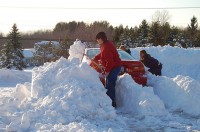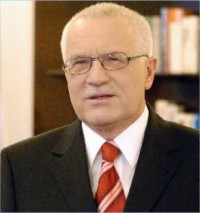
|
Mar 12, 2008
Is Climate Sensitive to Solar Variability?
By Nicola Scafetta and Bruce J. West
The causes of global warming-the increase of approximately 0.8plus or minus 0.1C in the average global temperature near Earth’s surface since 1900-are not as apparent as some recent scientific publications and the popular media indicate. We contend that the changes in Earth’s average surface temperature are directly linked to two distinctly different aspects of the Sun’s dynamics: the short-term statistical fluctuations in the Sun’s irradiance and the longer-term solar cycles. This argument for directly linking the Sun’s dynamics to the response of Earth’s climate is based on our research and augments the interpretation of the causes of global warming presented in the United Nations 2007 Intergovernmental Panel on Climate Change (IPCC) report.
Thus the average global temperature record presents secular patterns of 22- and 11-year cycles and a short timescale fluctuation signature (with apparent inverse power-law statistics), both of which appear to be induced by solar dynamics. The same patterns are poorly reproduced by present-day GCMs and are dismissively interpreted as internal variability (noise) of climate. The nonequilibrium thermodynamic models we used suggest that the Sun is influencing climate significantly more than the IPCC report claims. If climate is as sensitive to solar changes as the above phenomenological findings suggest, the current anthropogenic contribution
to global warming is significantly overestimated. We estimate that the Sun could account for as much as 69% of the increase in Earth’s average temperature, depending on the TSI reconstruction used. Furthermore, if the Sun does cool off, as some solar forecasts predict will happen over the next few decades, that cooling could stabilize Earth’s climate and avoid the catastrophic consequences predicted in the IPCC report. Read the full opinion here.

Nicola Scafetta is a research associate in the Duke University physics department. Bruce West is chief scientist in the mathematical and information science directorate, US Army Research Office, in Research Triangle Park, North Carolina.
Mar 11, 2008
Canada Again Blasted by Latest Weekend Storm
By Dr. Madhav, Khandekhar, retired Environment Canada Meteorologist
The March 8 2008 winter storm was perhaps 8th or 9th storm to hit the greater Toronto area since December 10 2007. This latest storm was a mammoth storm, a blizzard by definition with wind gusts close to 100 km/hr at times and wind chill values in the range of -20C ( ~-5F). Total snow fall out of this storm: 15-25 cm: more snow elsewhere, for example Ottawa ( Canada’s Capital city) received almost 50 cm of snow between Friday & Saturday, as did St. Catherines, a town of over 150K near Niagara Falls.
For the greater Toronto area, the total seasonal snow accumultaion so far: 195 cm ( Normal ~115 Cm), record snow fall in 1938-39 winter, 207 cm; with a few more weeks of below freezing temperatures to prevail, it is likely Toronto will surpass the all-time snow accumulation of 207 cm set in 1938-39
Day After Storm: Lots of snow in streets every where, very little has melted away as temperature continues well below normal, Monday ( March 10) morning temp is -14C in Markham (northeast of Toronto Downtown) and about -12C in Downtown Toronto (urban impact)
Elsewhere in the Canadian Maritimes: Almost record-breaking snow in New Brunswick, Newfoundalnd and PEI (Prince Edward Island) lots of snow ( more than normal ): mean temperature this winter season well below normal for most of the Maritime Provinces. This winter season ( 2007-08) season will definitely go down as one of the harshest & longest winters in Canada coast-to-coast, in almost 40 years.
See this story on ”The Winter Without End

Photo from Cleveland, Ohio to the south by Andre Bernier, WJW-TV, Cleveland, Ohio. See larger image here.
Andre adds the following: After running a snowfall departure all winter at the NWS Cleveland, we are now well into surplus. Oddly enough, the rest of the cities around us carried surpluses all year. As of today (snowfall departures):CLE = +13.1”, CAK = +27.2”, MFD = +39.9”, TOL = +17.8”, YNG = +48.5” !!!!!! Youngstown has now surpassed the previous snowiest winters in recorded history and we still have March and April to go.
Mar 07, 2008
Causes of Climate Change Varied: Canadian Poll Show No Consensus
By Gordon Jaremko, edmontonjournal.com
Only about one in three Alberta earth scientists and engineers believe the culprit behind climate change has been identified, a new poll reported today. The expert jury is divided, with 26 per cent attributing global warming to human activity like burning fossil fuels and 27 per cent blaming other causes such as volcanoes, sunspots, earth crust movements and natural evolution of the planet. A 99-per-cent majority believes the climate is changing. But 45 per cent blame both human and natural influences, and 68 per cent disagree with the popular statement that “the debate on the scientific causes of recent climate change is settled.”
The divisions showed up in a canvass of more than 51,000 specialists licensed to practice the highly educated occupations by the Association of Professional Engineers, Geologists and Geophysicists of Alberta. “We’re not surprised at all,” APEGGA executive director Neil Windsor said today. “There is no clear consensus of scientists that we know of.”
The only agreement among professionals is “we should do everything we can” to understand climate, adapt structures such as buildings and bridges to change and reduce human contributions to harmful trends, Windsor said. The survey received 1,077 replies or a sample rated as an accurate portrait of the occupational groups’ views to within three percentage points 19 times out of 20, APEGGA reported. Alberta Environment helped design the poll and will give the results to the provincial government, association spokesman Philip Mulder said. APEGGA is planning an “environmental summit” with other concerned agencies on Alberta climate change causes, effects and adaptations.
Mar 05, 2008
The 2008 International Conference on Climate Change
By Joseph D’Aleo, CCM
The opening remarks of the 2008 International Conference on Climate Change by Joseph L. Bast, President of the Heartland Institute site can be seen here. It kicked off the best climate conference I have attended in my 30 years in the professional societies. The two day meeting featured over 100 excellent presentations made by scientists from Australia, Canada, England, France, Hungary, New Zealand, Poland, Russia, Sweden, and of course the United States. They came from the University of Alabama, Arizona State, Carleton, Central Queensland, Delaware, Durham, and Florida State University, George Mason, Harvard, The Institute Pasteur in Paris, James Cook, John Moores, Johns Hopkins, and the London School of Economics, the University of Mississippi, Monash, Nottingham, Ohio State, Oregon State, Oslo, Ottawa, Rochester, Rockefeller, and the Royal Institute of Technology in Stockholm, the Russian Academy of Sciences, Suffolk University, the University of Virginia, Westminster School of Business (in London), and the Wharton School at the University of Pennsylvania. There were keynote addresses by Pat Michaels, Bob Balling, Ross McKitrick, Bill Gray, Tim Ball, Fred Singer, Roy Spencer and John Stossel. All were excellent and very well received. The most inspirational moments though were thanks to an address by the very courageous President of the Czech Republic, Vaclav Klaus, the only head of state of a major nation who “gets it”. A Ph.D. Economist by education, he was first elected president of the Czech Frepublic in 2003.

The text of his speech will be posted in its entirety on the Heartland website shortly but here are a few highlights.
“What I see in Europe (and the U.S. and other countries as well) is a powerful combination of irresponsibility, of wishful thinking, of implicit believing in some form of Mathusianism, of a cynical approach of those who themselves are sufficiently well off, together with the strong possibility of changing the economic nature of things through a radical political project.
As a politician who personally experienced communist central planning of all kinds of human activities, I feel obliged to bring back the already forgotten arguments used in the famous plan versus market debate in the 1930s in economic theory (between Mises and Hasyek on the one side and Lange and Lerner on the other), the arguments we have been using for decades - till the moment of the fall of communism. Then they were quickly forgotten. The innocence with which the climate alarmists and their fellow travelers in politics and mediia now present and justify their ambitions to mastermind human society belongs to the same “fatal conceit.” To my great despair, this is not sufficiently challenged neither in the field of social sciences, nor in the field of climatology. Especially the social sciences are suspicously silent.
We have to restart the discussion about the very nature of government and about the relationship between the individual and society. Now it concerns the whole mankind, not just the citizens of one particular country. To discuss this means to look at the canonically structured theoretical discussion about socialism (or communism) and to learn an uncompromising lesson from the inevitable collapse of communism 18 years ago. It is not about climatology. It is about freedom. This should be the main message of our conference.”
Icecap Note: The attendees left the conference with renewed vigor and enthusiam and many new contacts and ideas. Many told of countless others who wanted to join them but could not get time off from their jobs, could not afford the trip to New York City, or feared their attendance might affect their employment, a sad state of affairs. As I have noted this is not the sum total of the Climate Realists but the tip of the iceberg of what is very likely a silent majority of scientists in climatology, meteorology and allied sciences who do not endorse what is said to be the consensus position. There was a variety of opinions as there should be in science and all were tolerated. There was no group think or stagnant thinking as we find at other so called Climate Conferences. We thank the Heartland and the many other co-sponsors for their efforts in making this possible and so successful.
See conference summaries here, here, here.
Mar 04, 2008
Compilation of the Arguments That Irrefutably Prove that Climate Change is Driven by Solar Activity
Dr. Gerhard Lobert, Physicist. Recipient of The Needle of Honor of German Aeronautics
As the glaciological and tree ring evidence shows, climate change is a natural phenomenon that has occurred many times in the past, both with the magnitude as well as with the time rate of temperature change that have occurred in the recent decades. The following facts prove that the recent global warming is not man-made but is a natural phenomenon.
1. In the temperature trace of the past 10 000 years based on glaciological evidence, the recent decades have not displayed any anomalous behavior. In two-thirds of these 10,000 years, the mean temperature was even higher than today. Shortly before the last ice age the temperature in Greenland even increased by 15 degrees C in only 20 years. All of this without any man-made CO2 emission!
2. There is no direct connection between CO2 emission and climate warming. This is shown by the fact that these two physical quantities have displayed an entirely different temporal behavior in the past 150 years. Whereas the mean global temperature varied in a quasi-periodic manner, with a mean period of 70 years, the CO2 concentration has been increasing exponentially since the 1950’s. The sea level has been rising and the glaciers have been shortening practically linearly from 1850 onwards. Neither time trace showed any reaction to the sudden increase of hydrocarbon burning from the 1950’s onwards.
3. The hypothesis that the global warming of the past decades is man-made is based on the results of calculations with climate models in which the main influence on climate is not included. The most important climate driver (besides solar luminosity) comes from the interplay of solar activity, interplanetary magnetic field strength, cosmic radiation intensity, and cloud cover of the Earth atmosphere. Read more here.
|
|
|
|





